What to do if a crypto exchange blocks your account?
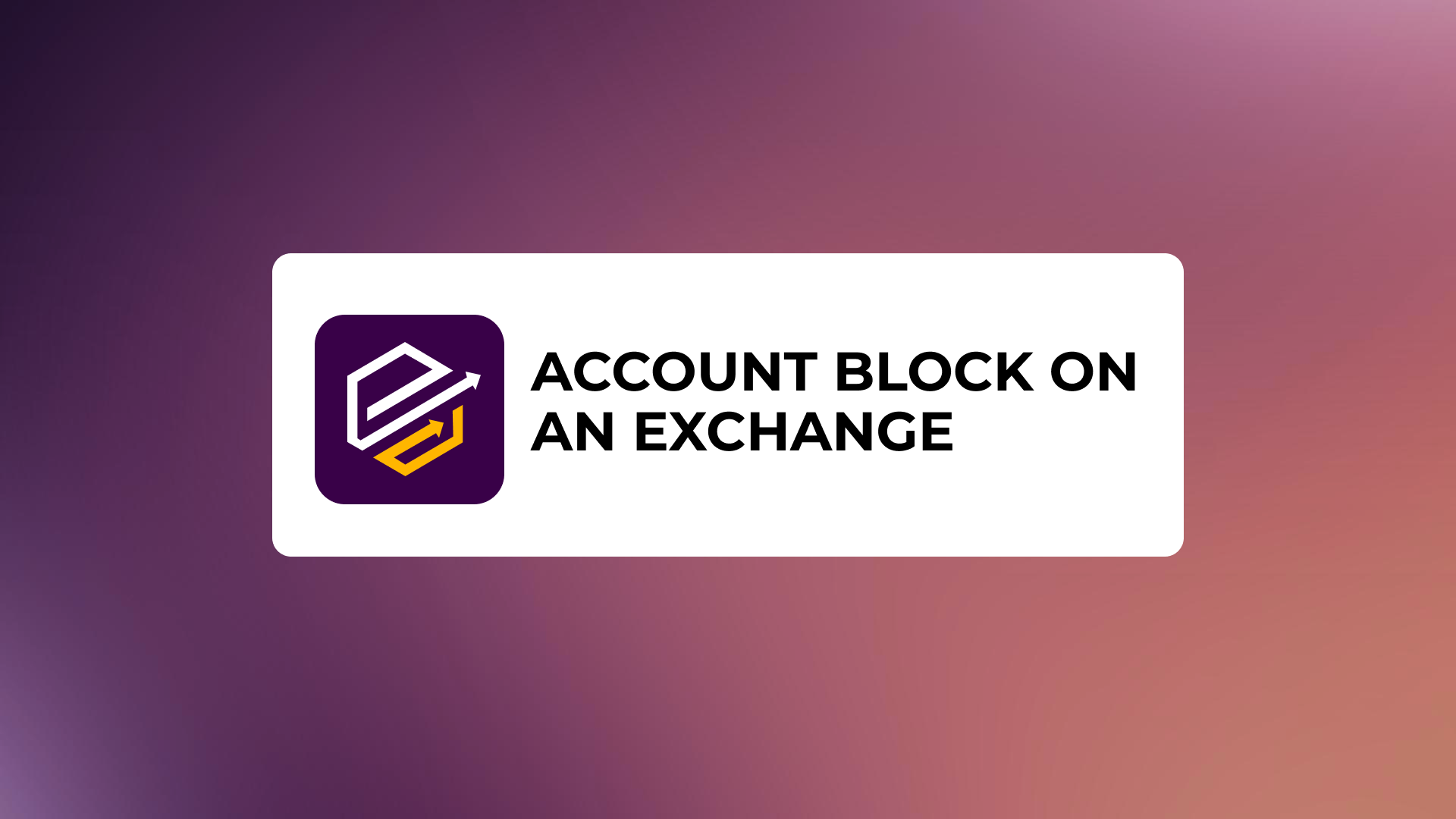
Blocking an account on an exchange is a situation that can take anyone by surprise. Unfortunately, such cases are not uncommon in the cryptocurrency world. The reasons for blocking can be very different: from suspicions of money laundering to trivial technical errors. But regardless of the reason, the sudden loss of access to the account and funds on it always causes stress and anxiety.
In this article, we will analyze in detail why account blocking occurs on crypto exchanges, and most importantly – what to do if it happened to you. You will learn about the possible causes, how to properly interact with the exchange and what steps to take to restore access. We will also tell you how to minimize the risks of blocking in the future.
Contents
- Reasons for account blocking
- How to find out the reasons for blocking
- Actions you can take
- How to appeal the Exchange’s decision
- Precautions to prevent future blockages
- What to do if the exchange does not respond
- Conclusion
Reasons for account blocking
Before looking into what to do when your account is blocked, it is important to understand why it happens at all. After all, knowing the cause, you can more quickly find a solution to the problem. So, the main reasons for blocking accounts on crypto exchanges:
| Violation of exchange rules | Each crypto exchange has its own terms of service and rules, which the user accepts when registering. If you commit actions contrary to these rules, the exchange has the right to block your account. Examples of violations: attempts to manipulate the market, use of prohibited trading software (third-party scripts), multiple account registrations, transferring your account to third parties, etc. |
| Suspicion of fraud or money laundering | Cryptocurrency exchanges are required to comply with anti-money laundering (AML) and terrorist financing legislation. If your actions seem suspicious, for example, frequent transfers of large sums of money to/from third-party wallets, trading at abnormal volumes, the exchange may block your account for verification. The same if there is a request from law enforcement authorities as part of an investigation. |
| Problems with identity verification | Virtually all exchanges require a Know Your Customer (KYC) procedure to verify your identity. If there are questions about your personal data or documents, your account may be temporarily blocked. This can also happen if you do not pass the next verification stage in time when you reach a certain trading turnover. |
| Technical failures and errors | Although it happens infrequently, blocking is possible due to a technical failure in the exchange system or an error by administrators. For example, automatic protection algorithms may mistakenly take your activity as suspicious and block your account. Or the administrator may accidentally include your account in the list of bots during mass blocking. Usually such errors are quickly corrected by contacting technical support. |
It is important to understand that account blocking is a standard security procedure on crypto exchanges. Its purpose is to protect both the exchange itself and honest users from possible fraudulent actions. Therefore, if your account is blocked, you should not take it as a personal attack or an attempt to seize your funds. Most likely, the blocking is temporary and you will be able to solve the problem if you act correctly.
In the next section, we’ll look at what you need to do to find out the exact reason for the blocking and start the process of restoring access to your account.
How to find out the reasons for blocking
So, you have discovered that your account on a crypto exchange is blocked. The first thing you need to do is to try to find out the reason for the blocking. The sooner you do this, the sooner you can start solving the problem. Here are a few steps that will help you find out the reason.
- Check notifications and messages from the exchange. Usually, when an account is blocked, the exchange sends a notification to the user’s e-mail or personal cabinet. This message often contains the reason for the blocking and further instructions. So first check your email and the message section of the exchange itself. If you find such a notification, read it carefully.
- Study the history of your account. Even if you did not receive messages from the exchange, you can try to find out the reason for the blocking yourself. To do this, look through the logs of account logins (activity log), history of transactions and trading operations. Pay attention to any suspicious activity that could be a trigger for blocking. For example, logging into the account from an unfamiliar location, a sharp increase in trading volumes, a large number of transfers to external wallets, etc.
- Contact the exchange support service. If the reason for blocking is not clear from notifications or account history, write to the exchange’s technical support. Clearly and calmly describe the situation, indicate when you discovered the blocking and what actions you took to find out the reasons. Be sure to request information about the reason for the blocking and further steps to unblock the account. Be ready to provide additional information upon request.
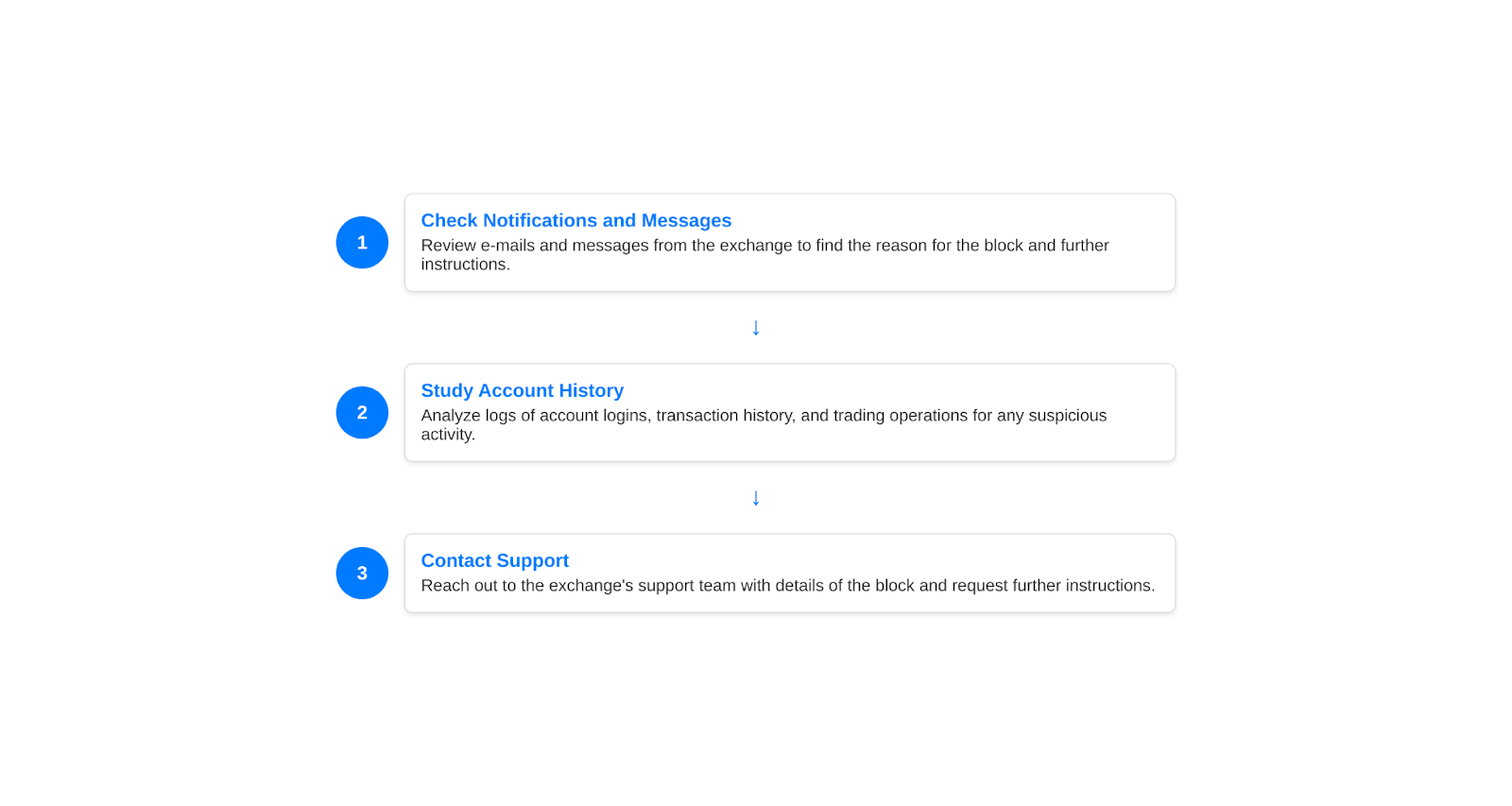
Do not hesitate to ask clarifying questions if the support response is incomplete or unclear. Keep in mind that the first line of support does not always have complete information, so it may be necessary to escalate the issue to a higher level. Most importantly, don’t give up and insist on your right to know the reason for the block.
If the reason for blocking remains unclear after contacting support, you can try to consult on forums or in trading communities. Perhaps, someone has faced a similar situation and will be able to tell you what may be the matter.
It is important to realize that finding out the reason for the blocking is the key point. Without it, you will not be able to take the right steps to solve the problem. Therefore, don’t be lazy to spend time searching for information and communicating with the exchange. This will help save your nerves and time in the future.
In the next section, we’ll look at what specific actions to take when the reason for the blocking is already known.
Actions you can take
When the reason for blocking the account is known, you can move to active actions to solve the problem. Specific steps depend on the cause, but there are a few universal recommendations:
- Gather all necessary documents to verify your identity. If the blocking is due to verification issues, you will need to provide the exchange with documents confirming your identity. Usually, this is a scan of your passport or other ID, sometimes a document of your place of residence (for example, a utility bill). Be prepared to also confirm the source of origin of funds on the account (payroll statements, contracts, etc.).
It is important that all documents are up to date, clear and fully legible. Do not try to forge documents or provide false information – this will only worsen the situation. If you don’t have a certain document at hand, honestly inform the exchange and find out alternative options for proving your identity.
- Correct the violations if the blocking is due to your faulty actions. It happens that an account is blocked due to unintentional actions of the user himself. For example, you may have accidentally accessed the exchange via VPN, which was considered as suspicious activity. Or your API key got into the hands of third parties. In such cases, after finding out the reason, you should immediately take measures to correct the situation: disable VPN, generate new API keys, change your password, etc.
After that, write to the exchange’s support, clearly describe what actions you have taken to eliminate violations and ask to unblock the account. Be prepared that the exchange may request additional confirmation or impose restrictions on the account for some time after unblocking.
- Contact the exchange support to find out the details of the blocking and further steps. Even if the reason for the blocking is clear to you, it is always a good idea to check the details with the exchange staff. Perhaps you missed some nuance or there are additional requirements that you do not know about. So be sure to write to support, tell them about your findings regarding the reason for the blocking and ask what specific steps you need to take to unblock.
Remember that the exchange is interested in honest users, so in most cases it will meet your needs if you act consistently and constructively. However, be prepared that the unblocking process may take some time, especially if the situation is ambiguous. Be patient and don’t give up if your first attempts are unsuccessful.
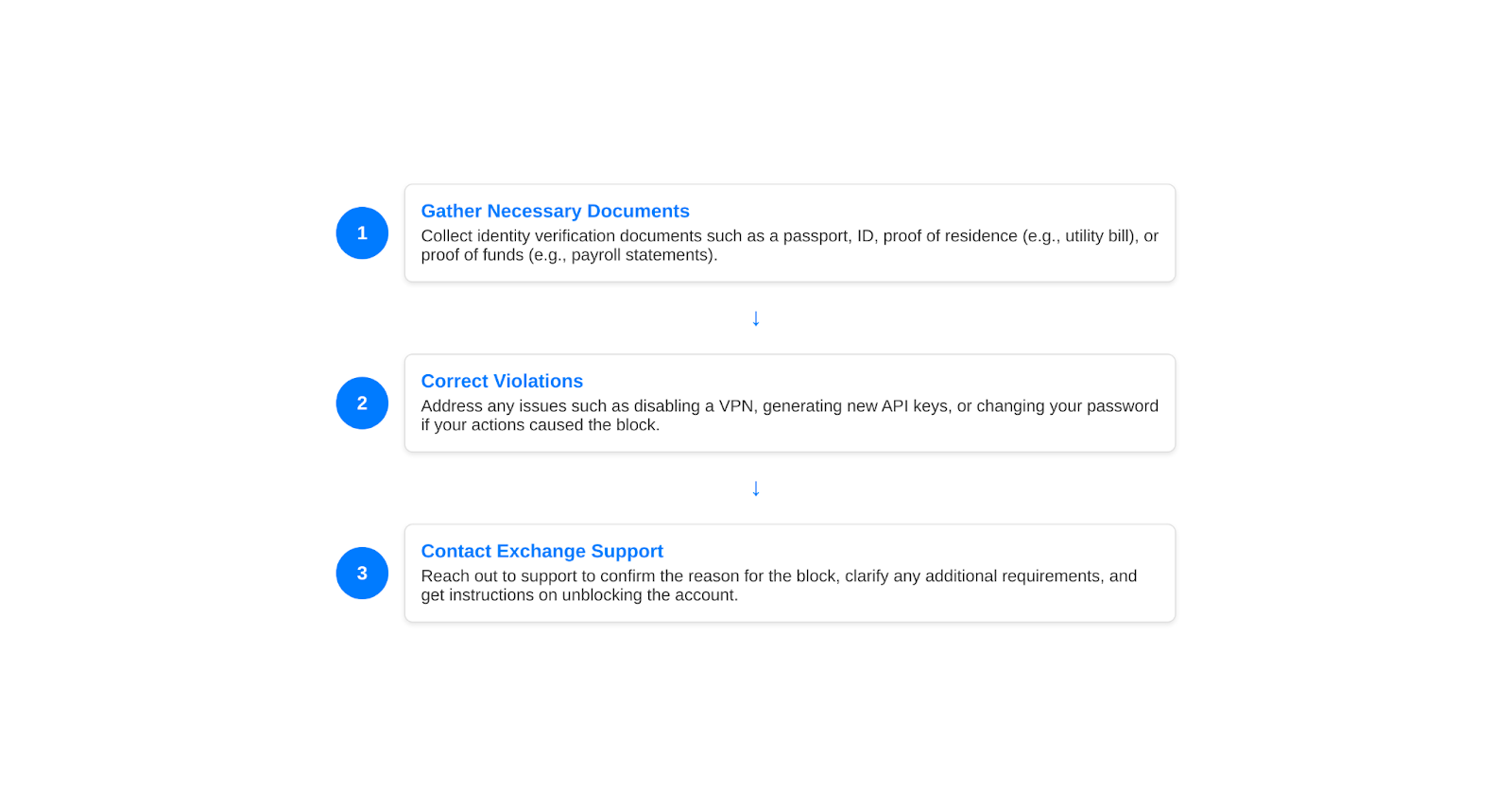
How to appeal the Exchange’s decision
If you believe that the blocking of your account was unjustified or unfair, you have the right to appeal the exchange’s decision. However, you need to do it correctly to avoid making the situation worse. Here is a step-by-step plan of action:
- Prepare a formal complaint or appeal. This should be a clearly structured document in which you state the essence of the problem, describe the history of your interaction with the exchange and explain why you consider the blocking to be unlawful. It is advisable to support your position with screenshots of correspondence, extracts from your account history and other evidence.
When making an appeal, rely on the facts and the specific clauses in the Exchange’s User Agreement. Avoid emotional statements and accusations – they will only turn the Exchange against you. Your goal is to clearly and reasonably present your position and get a fair decision.
- Indicate the legitimate grounds for restoring access. When blocking your account, the exchange must act within the law and its internal rules. Therefore, in your appeal, cite specific laws or clauses in the User Agreement that give you the right to access your account.
For example, if the exchange does not provide a clear explanation of the reasons for the blocking – this is a violation of your rights as a consumer. If the exchange refuses to unblock your account after you have eliminated all violations – this may be a breach of contract. If you suspect that the blocking is related to a data leak or hacking on the exchange’s side, mention the exchange’s responsibility for the safety of user data.
- Proceed step by step and persistently. Start by sending an official complaint to the exchange’s support team. If you don’t receive a response within a few days or the response is unsatisfactory, write again and demand that the issue be escalated to the management level. At the same time, you can try to reach out to the exchange through public channels – social networks, thematic forums, rating platforms.
At every stage, record all communication with the exchange – save correspondence, record calls (with a warning to the interlocutor). This will help to defend your position in case of further proceedings.
The most important thing when appealing the decision of the exchange – do not give up and methodically defend your interests. Often exchanges backtrack when they see that the user is serious and ready to go to the end. So be persistent, but always keep a constructive approach. Remember that your goal is not to punish the exchange, but to restore justice and regain access to your funds.
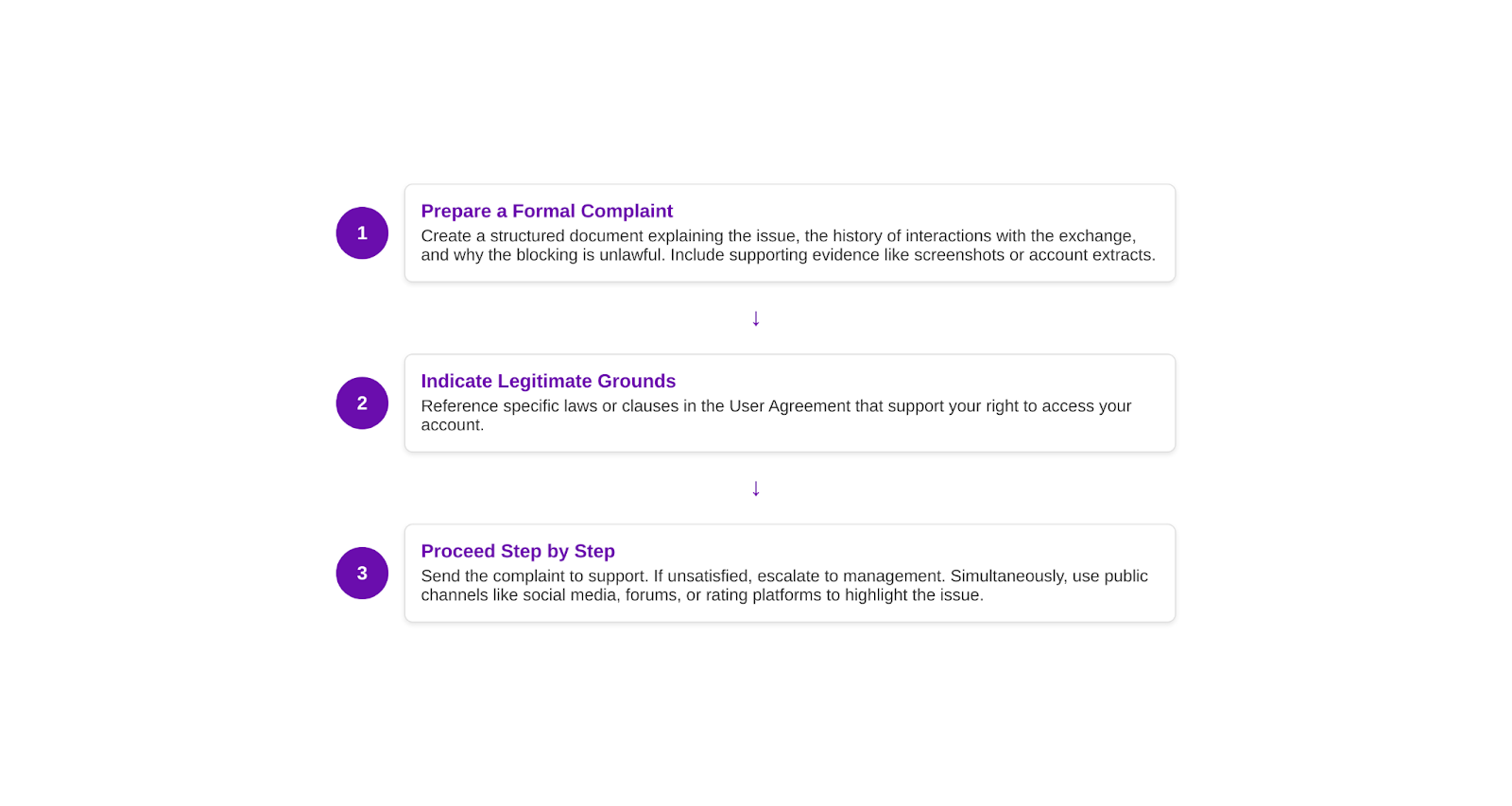
Precautions to prevent future blockages
It is much easier to prevent the blocking of an account on a crypto exchange than to restore access later. Therefore, every user should take care of the security of his account and compliance with the rules of the exchange in advance.
Exchange Rules Compliance
- The first and most important rule is to carefully read and strictly comply with the terms of use and security policy of the exchange. Yes, these are boring legal documents, but they spell out all the requirements and restrictions that the exchange imposes on users. Violation of these rules is the most common reason for blocking. Therefore, spend time studying these documents and strictly follow them in your trading activities.
Verification and KYC/AML
- Another important aspect is to regularly update your personal data and undergo verification. Exchanges are required to comply with KYC/AML procedures, so they may periodically ask users for updated documents or additional information. Do not ignore such requests and provide all necessary data in a timely manner. This will help avoid verification issues and related blocking.
Two-Factor Authentication
- As for the technical side of security, two-factor authentication (2FA) is a must. This can be an SMS code, an authenticator app, or a hardware security key. 2FA makes it much more difficult for unauthorized access to your account, even if your password is compromised. Therefore, it is highly recommended to enable two-factor authentication in your account security settings.
Cybersecurity
- It is also important to follow the basic rules of cyber hygiene: use complex and unique passwords for each exchange, do not click on suspicious links, do not download unverified programs, and regularly check your computer for viruses. All this reduces the risk of your account being hacked and then blocked on suspicion of fraud.
Trading Discipline
- Finally, be careful and cautious in your trading activity. Surges in trading volume, abnormal transactions, and attempts to manipulate the market all attract the attention of the exchange’s security department and can lead to blocking. Adhere to a consistent and transparent trading strategy, do not try to cheat the system.
Observing these simple but important precautions will help you minimize the risks of account blocking on crypto exchanges and maintain unhindered access to your funds. Remember that the security of your account is primarily your responsibility. The exchange can help, but the main job of preventing problems lies with you as a user.
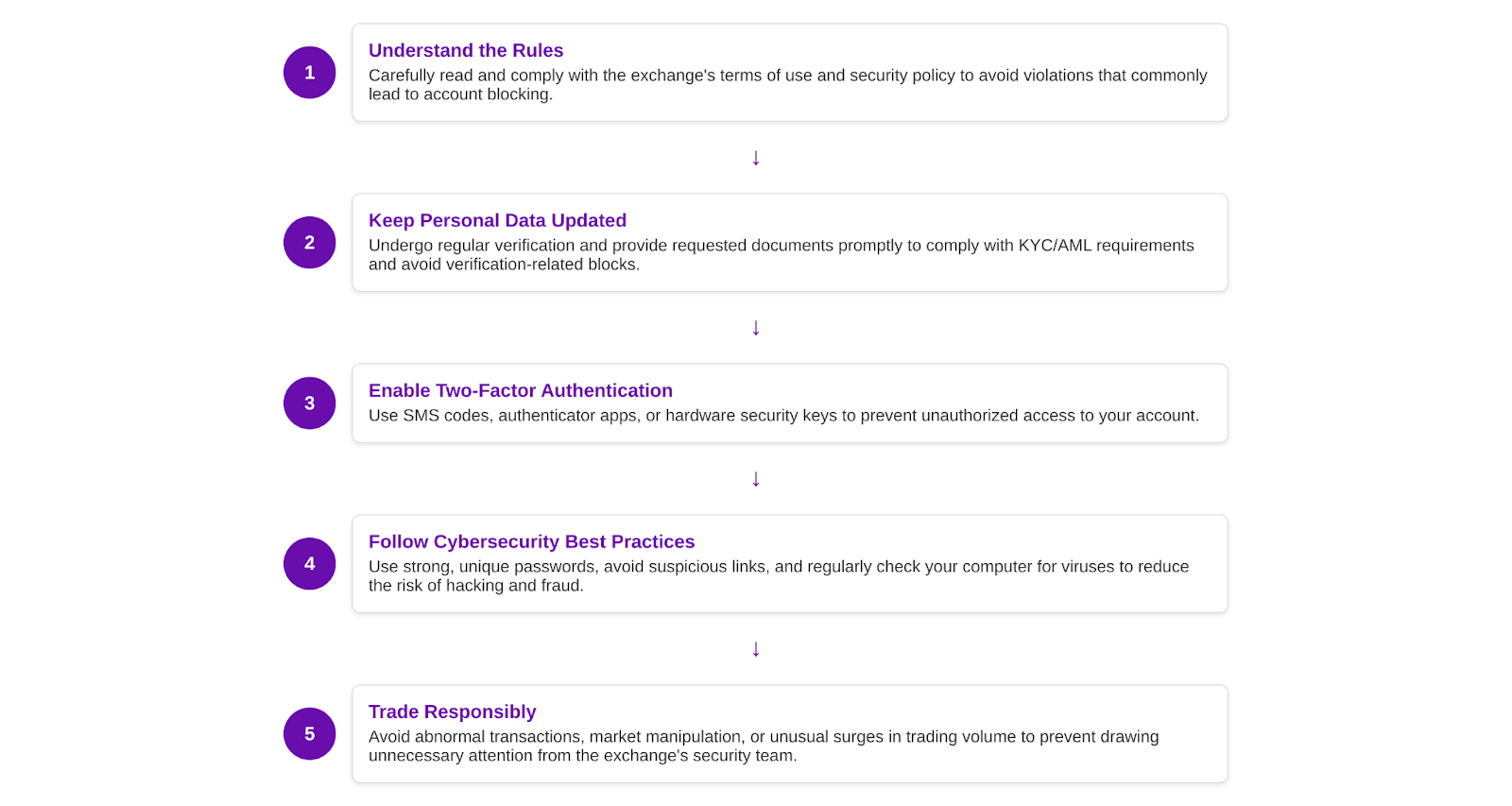
What to do if the exchange does not respond
One of the most unpleasant situations when your account is blocked on a crypto exchange is when the exchange stops responding to your requests. You send letters to support, but there is no response or only formal replies. In this case, it is important not to give up and continue to methodically seek a solution to the problem.
Alternative Communication Channels
- The first thing you should do is to try alternative ways of contacting the exchange. If traditional support tickets do not work, write to the official accounts of the exchange in social networks – Twitter, Facebook, Telegram. Often exchanges are more responsive to public messages to avoid reputational risks. You can also look for other communication channels on the exchange’s website – feedback form, chat, hotline.
Personal Staff Contacts
- If this doesn’t help either, try to find personal contacts of the exchange’s employees – for example, LinkedIn accounts or email addresses from the corporate domain. Write them a personal message with a brief description of the problem and a request to help or redirect your request to a competent specialist. Of course, you can’t expect a miracle, but sometimes this informal approach works.
Legal Support
- In parallel with trying to get through to the stock exchange, it is worth considering engaging a legal advisor, especially if the situation is protracted or involves significant sums. An experienced lawyer will help to draw up a claim correctly and, if necessary, prepare documents to apply to regulatory authorities or the courts. Sometimes the mere mention of a willingness to go to court can encourage the exchange to dialog.
Official Complaint
- But even without a lawyer, you can start formal correspondence with the exchange. Send a registered letter with a detailed description of the situation and a demand to unblock your account to the exchange’s legal address (it can be found in the user agreement or public registers). Clearly indicate the timeframe in which you expect a response and state your readiness to defend your rights in the legal field.
Appeals to Regulatory Bodies
- If this does not work, you will have to contact the regulatory authorities – local or international, depending on the jurisdiction of the exchange. Collect all the documentation on your case (screenshots of correspondence, transaction history, etc.), draft a clear and concise complaint, and send it to all relevant authorities.
Public Exposure
- In the most extreme case, when all attempts to reach the exchange have been exhausted, there is an option of public attention through the media and the crypto community. Write about your problem on thematic forums, social networks, and contact crypto publications. Perhaps the public outcry will force the exchange to make contact.
The most important thing in this unpleasant situation is not to keep silent and methodically look for ways out. Yes, it takes time, effort and sometimes money. But according to the experience of many users, persistence and perseverance eventually bring results. Exchanges are not interested in long public conflicts, so sooner or later they are forced to go to dialog.
Of course, it is better to initially choose large and regulated exchanges with a good reputation and adequate support service. But even with them, problems can arise. Therefore, be prepared to defend your rights as a user by all available means. And do not forget about prevention – follow the rules of the exchange, monitor the security of your account, and be careful in your trading activity. This will help minimize the risks of blocking in the future.
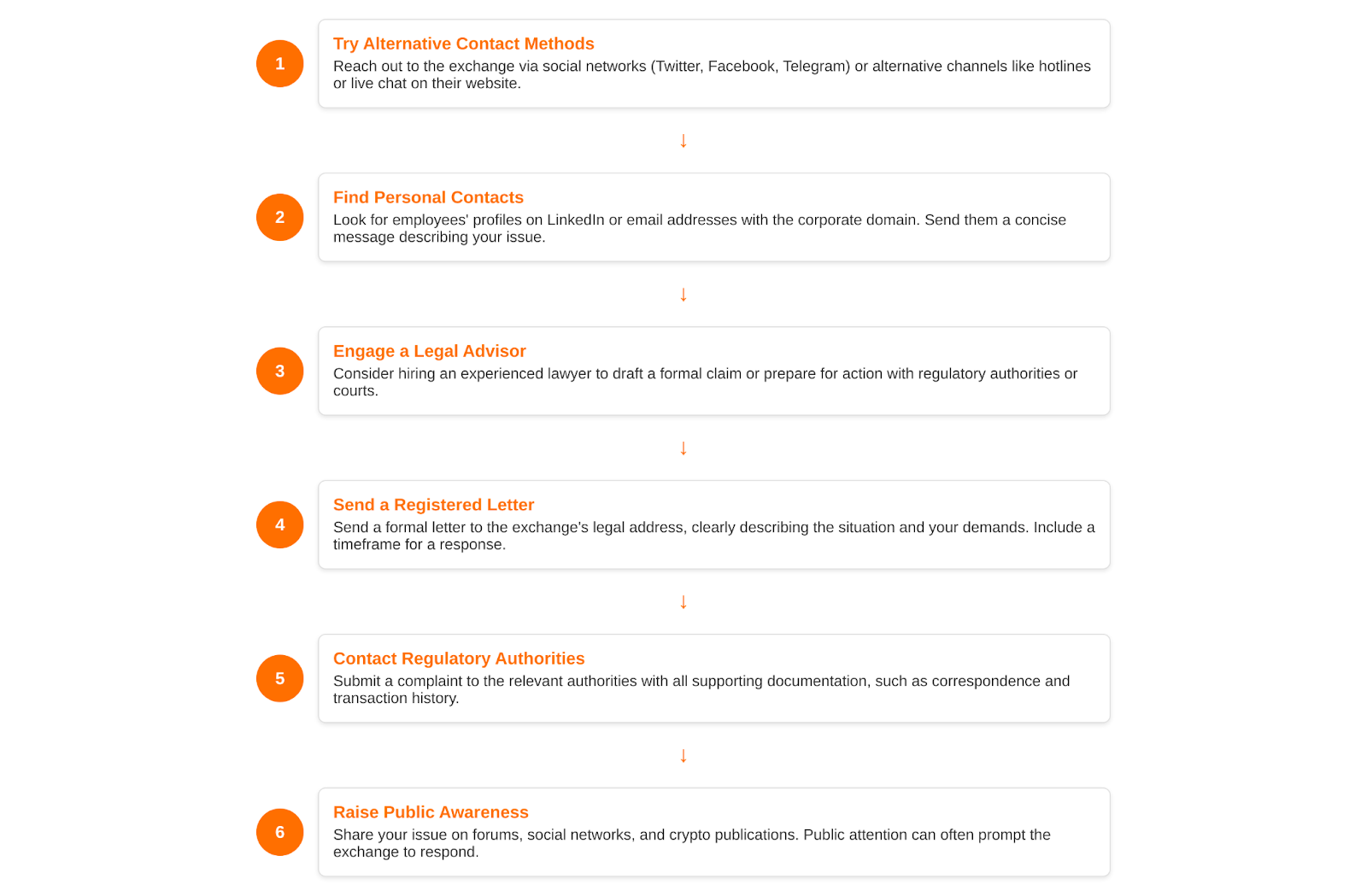
Conclusion
Blocking an account on a crypto exchange is an unpleasant but solvable problem. The main thing is not to panic and act consistently. Find out the reason for the blocking, collect the necessary documents, eliminate violations, if any. Actively communicate with the exchange, do not hesitate to escalate the issue and involve lawyers. As a last resort, contact regulatory authorities and the media.
But the best way to solve problems is prevention. Choose reliable exchanges, follow their rules, and take care of account security. This will minimize the risks of blocking and save your nerves and money.
Remember that even in the most difficult situation there is a way out. Be persistent, consistent and do not give up. The experience of many traders shows that persistence and the right approach help to achieve justice and regain access to their funds. Good luck!